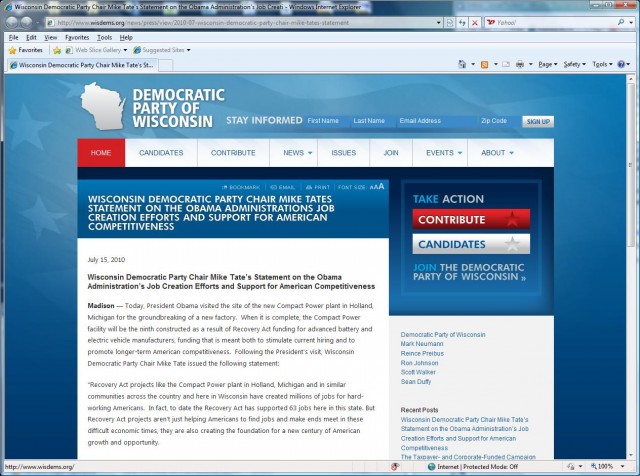I am rather hesitant to talk about the latest Badger Poll on the gubernatorial and U.S. Senate races (#30 for those coming here after the next one comes out) for several methodology reasons, but since polling is the spice of political life, I’ll do it. The big problem with the poll is the University of Wisconsin Survey Center, which conducted the poll, took 31 days, between June 9 and July 10, to get to 500 adults (466 registered voters and 297 likely voters). 31 days is a couple of eternities in politics. This effect is especially pronounced in the Senate race, where Ron Johnson, the Republican candidate the pollsters asked about, had just started a major ad campaign. This is borne out through Rasmussen’s polling, where 32% of those surveyed at the end of May had not heard enough about Johnson to form an opinion. That number dropped to 24% at the end of June and 18% this week.
Related to that, the UW crew did not attempt to force anybody who did not express an immediate preference to choose a candidate, though they do promise to do so in the next poll. In the Senate race, a full 55% of all those surveyed, 51% of registered voters, and 38% of likely voters (the last representing a plurality) did not express an immediate preference. On the gubernatorial side, 52% of those surveyed, 48% of registered voters, and 37% of likely voters did not express an immediate preference.
The last major flaw is that the UW crew did not even attempt to separate Scott Walker and Mark Neumann in the head-to-head against Tom Barrett. Instead, the second half of the “who would you vote for” question used “one of the Republican candidates”.
Related to that, the while the actual head-to-head question did randomly rotate between the Republican and the Democrat, and the favorability question was similarly rotated among the people asked about, the Democrat was always named first in the lead-up to the head-to-head question.
I suppose I should start with the biggest bit of news – the partisan split. The difference between the overall split of 40% independent/other, 31% Democrat, 29% Republican and the the likely-voter split of 40% independent/other, 36% Republican, 24% Democrat (mentioned in the gubernatorial poll release) can only be good news for Republicans and bad news for Democrats. Indeed, a very-quick look back through the archives did not find a previous mention of the demographics of who the pollsters determined to be likely voters.
Among those relatively-few likely voters, Russ Feingold leads Ron Johnson 33%-28%. However, beyond the caution flags of the high undecided percentage and the lengthy time of the poll at a point where one of the candidates was still in the process of introducing himself, there is a third item – that lead is still within the 5.7% margin of error for the small sample size. Further, 87% of those surveyed and 80% of likely voters didn’t know enough about Johnson to form an opinion.
What can be inferred from the overwhelming preference for a Republican versus Tom Barrett for governor (overall 32%-15%, and 43%-19% among likely voters) is that Wisconsin simply does not want a third Jim Doyle term. It also shows that the anti-Milwaukee factor in Northern Wisconsin (defined by UW as pretty much everything north of Highway 33) is pretty much overrated, though most of those in Norther Wisconsin haven’t heard of any of the candidates. Walker’s favorability split in Southern Wisconsin is 33% favorable/20% unfavorable, and his favorability split in Northern Wisconsin is 17% favorable/7% unfavorable. Mark Neumann’s favorability split in the south is 18% favorable/16% unfavorable, and his favorability split in the north is 15% favorable/7% unfavorable. Tom Barrett’s favorability split in the south is 33% favorable/25% unfavorable, and his favorability split in the north is 23% favorable/13% unfavorable.
